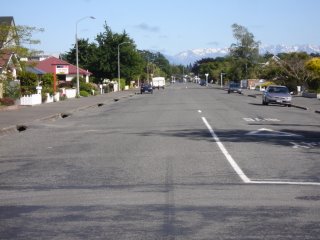Ashburton Town
These are Happy Cattle over 1000 in this field

Typical Ashburton Road note how wide it is.

I am now in Ashburton and the journey down here was on a boring road that is flat, trees lined and full of fields with thousands upon thousand of diary cattle and sheep. The only relief from the monotony was after every 15 kilometres a slight bend in the road would appear. I think they put them in to stop you falling asleep. The Ashburton Parish also looks after the parishes of Rakaia and Methven so on the way to Ashburton I drive through the villages to see what they look like. Rakaia is a small village with about 800-1000 people. Methven is at the bottom of Mount Hut and is a ski village with about 1500 people. But as it is the spring and the snows fast receding the town is virtually empty. They are now waiting for the summer ramblers to appear. Methven is less than twenty minutes from the Rakaia gorge which is very beautiful and ideal for rambling, which I seem to be doing writing this passage.
The Ashburton town is a small country town. 99.9% of the houses are bungalows. So it is a very flat town in more ways than one. The only three floored building is the home defence. (Don’t even go there) The main industry around the area of Ashburton is farming dairy and beef herds and sheep and deer. At the last count there were 35 million cattle and 40 million sheep. Its statistics like this that helps you understand why the hole in the ozone layer around New Zealand is bigger than anywhere else. The methane level here is so high because of the high amount of cattle and sheep effluent . On top of that rearing cattle is the most inefficient and wasteful of the worlds resources than any other form of food gathering.
The Ashburton town is a small country town. 99.9% of the houses are bungalows. So it is a very flat town in more ways than one. The only three floored building is the home defence. (Don’t even go there) The main industry around the area of Ashburton is farming dairy and beef herds and sheep and deer. At the last count there were 35 million cattle and 40 million sheep. Its statistics like this that helps you understand why the hole in the ozone layer around New Zealand is bigger than anywhere else. The methane level here is so high because of the high amount of cattle and sheep effluent . On top of that rearing cattle is the most inefficient and wasteful of the worlds resources than any other form of food gathering.
I was taken to a farm operated by a Japanese company and I must say that our animal rights activists would have a fit if we ran anything like this in England. The company sells their meat only to the Japanese market. The cattle are black Aberdeen Angus. No white or other colour is allowed. The young calves are brought to the factory and are fed day and night with a rich feed mix that is chemically grown around the local area. Over a thousand cattle are made to stay in lines no wider than three meters wide and there are rows and rows of them. On either side of the rows are troughs where food is constantly supplied and this is all built on concrete. There are no sheds for the cattle and they are open to all the elements, from the blazing sun, the torrential rain or the really cold weather that occurs here. Once the calves arrive here they never again see or eat a blade of grass. There is no such thing as chewing the cud for these poor beasts. As you are well aware when you have had a big meal one likes to sit down and rest but these poor animals are not allowed to. The simple reason being that they are so obese if they were allowed to lie down they would never be able to get up again. Therefore there are men who spend their working hours on a horse prodding those cattle who try to lay down to get on their feet. The Japanese by all accounts like their beef meat red and marble looking but if this is the only way to produce it, I’ll stick to my beans thank you very much!


0 Comments:
Post a Comment
<< Home